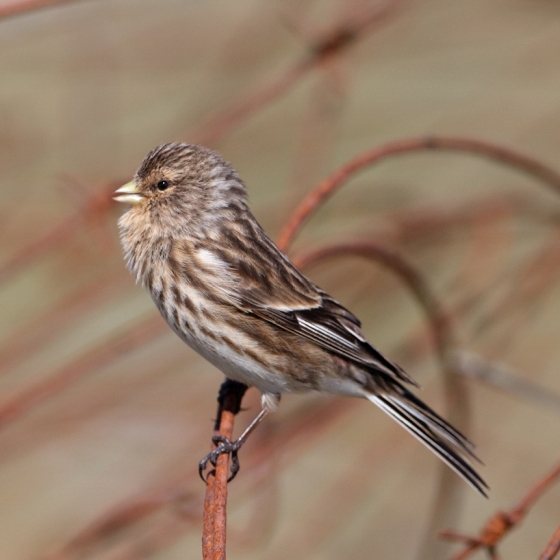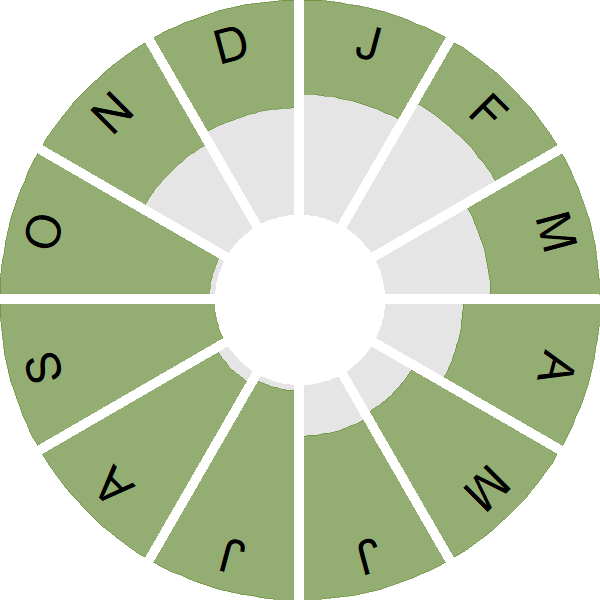Twite

Introduction
This small, brown finch with a yellow bill and pink rump is very much a bird of coastal fringes and higher ground.
There is little colouration difference between the males and females though males do tend to be more brightly marked. The Twite has a northerly breeding distribution in Britain & Ireland, and is often referred to as the 'Linnet of the north'. However, during the winter months it may be found on southerly coasts seeking out the small seeds that can gather on the tideline of saltmarsh and dune.
The Twite has been Red-listed in the UK since 1996 due to a reduction in its breeding population. Its small breeding population is supplemented in winter by birds arriving from elsewhere in Europe.

Key Stats
Identification
ID Videos
This section features BTO training videos headlining this species, or featuring it as a potential confusion species.
Linnet & Twite
Songs and Calls
Song:
Call:
Status and Trends
Conservation Status
Population Change
The status of breeding Twite in the UK is uncertain but evidence collected from various sources including county bird reports suggests that a substantial decline has occurred in England since the 1970s (Raine et al. 2009) and the number of occupied squares in Britain declined by 19% between 1968–72 and 2008–11 (Balmer et al. 2013). A baseline survey of breeding Twite in the UK came up with an estimate of approximately 10,000 pairs in 1999 (Langston et al. 2006). A repeat survey in 2013 suggests that a moderate decline may have occurred since 1999; the 2013 survey came up with an estimate of 7,831 pairs with 97.6% of the population in Scotland (Wilkinson et al. 2018). The UK wide population decline between 1999 and 2013 was not statistically significant, however, although a significant decline of 72% had occurred in England.
Distribution
Breeding Twites have been declining for several decades and the distribution may now be less extensive than these maps from 2008–11 suggest. At that time Twites bred throughout the Northern Isles and close to the western seaboard of Scotland, with inland upland populations primarily in the Scottish Highlands and the Pennines. A few pairs remained in North Wales, the Southern Uplands and the coastal fringes of northwest Ireland. Highest densities were in Shetland, Orkney and Caithness and on the Hebrides and their adjacent mainland coast. In winter birds aggregate on the Northern Isles, especially Orkney, and the Hebrides between North Uist and Islay. Further south, large estuaries such as Morecambe Bay, the Humber and the Wash have traditionally attracted substantial flocks to feed in saltmarshes, but these too are declining.
Occupied 10-km squares in UK
2007/08–10/11
or view it on Bird Atlas Mapstore.
2008–11
or view it on Bird Atlas Mapstore.
European Distribution Map
Distribution Change
The Twites breeding range has contracted by 80% in Ireland and by 19% in Britain since the 1968–72 Breeding Atlas. The Irish winter range has also contracted, by 30%. Surprisingly, given the population trajectory, the winter range in Britain has expanded by 19%.
Change in occupied 10-km squares in the UK
from 1981–84 to 2007–11
or view it on Bird Atlas Mapstore.
from 1968–72 to 2008–11
or view it on Bird Atlas Mapstore.
Seasonality
Twite is a localised and declining breeder and winter visitor.
Weekly pattern of occurrence
The graph shows when the species is present in the UK, with taller bars indicating a higher likelihood of encountering the species in appropriate regions and habitats.

Movement
Britain & Ireland movement
Foreign locations of birds ringed or recovered in Britain & Ireland
Dots show the foreign destinations of birds ringed in Britain & Ireland, and the origins of birds ringed overseas that were subsequently recaptured, resighted or found dead in Britain & Ireland. Dot colours indicate the time of year that the species was present at the location.
- Winter (Nov-Feb)
- Spring (Mar-Apr)
- Summer (May-Jul)
- Autumn (Aug-Oct)

European movements
EuroBirdPortal uses birdwatcher's records, such as those logged in BirdTrack to map the flows of birds as they arrive and depart Europe. See maps for this species here.
The Eurasian-African Migration Atlas shows movements of individual birds ringed or recovered in Europe. See maps for this species here.
Biology
Productivity and Nesting
Nesting timing
Egg measurements
Clutch Size
Incubation
Survival and Longevity
Survival is shown as the proportion of birds surviving from one year to the next and is derived from bird ringing data. It can also be used to estimate how long birds typically live.
View number ringed each year in the Online Ringing Report.
Lifespan
Biometrics
Wing length and body weights are from live birds (source).
Wing length
Body weight
Ring Size
Classification, names and codes
Classification and Codes
- Order: Passeriformes
- Family: Fringillidae
- Scientific name: Linaria flavirostris
- Authority: Linnaeus, 1758
- BTO 2-letter code: TW
- BTO 5-letter code: TWITE
- Euring code number: 16620
Alternate species names
- Catalan: passerell becgroc
- Czech: konopka žlutozobá
- Danish: Bjergirisk
- Dutch: Frater
- Estonian: mägi-kanepilind
- Finnish: vuorihemppo
- French: Linotte à bec jaune
- Gaelic: Gealan-beinne
- German: Berghänfling
- Hungarian: sárgacsoru kenderike
- Icelandic: Lyngfinka
- Irish: Gleoiseach Sléibhe
- Italian: Fanello nordico
- Latvian: kalnu kegis
- Lithuanian: geltonsnapis civylis
- Norwegian: Bergirisk
- Polish: rzepoluch
- Portuguese: pintarroxo-de-bico-amarelo
- Slovak: stehlík horský
- Slovenian: severni repnik
- Spanish: Pardillo piquigualdo
- Swedish: vinterhämpling
- Welsh: Llinos y Mynydd
- English folkname(s): Mountain Linnet
Research
Causes of Change and Solutions
Causes of change
The drivers of declines in Twite populations are uncertain and further research is needed. Potential factors could include conversion of hay meadows to pasture, overgrazing and poor burning practices, leading to a reduction in foraging opportunities and nesting habitat, and changes to wintering habitat (Langston et al. 2006). A study of breeding ecology on the Western Isles in Scotland found that marginal low-intensity arable farmland and grassland habitats adjacent to moorland were important foraging habitats and suggested that reductions in such habitat may be contributing to local declines (Wilkinson & Wilson 2010).
More Evidence
More evidence from Conservation Evidence.com
Partners
Citing BirdFacts
If you wish to cite particular content in this page (e.g. a specific value) it is best to use the original sources as linked in the page. For a more general citation of the whole page please use: BTO (20XX) BirdFacts Species: profiles of birds occurring in the United Kingdom. BTO, Thetford (www.bto.org/birdfacts, accessed on xx/xx/xxxx).

